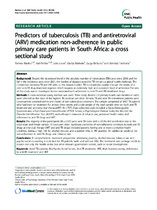| dc.contributor.author | Naidoo, Pamela | |
| dc.contributor.author | Peltzer, Karl | |
| dc.contributor.author | Louw, Julia | |
| dc.contributor.author | Matseke, Gladys | |
| dc.date.accessioned | 2017-02-20T12:32:03Z | |
| dc.date.available | 2017-02-20T12:32:03Z | |
| dc.date.issued | 2013 | |
| dc.identifier.citation | Naidoo, P. et al. (2013). Predictors of tuberculosis (TB) and antiretroviral (ARV) medication non-adherence in public primary care patients in South Africa: A cross sectional study. BMC Public Health, 13:396 | en_US |
| dc.identifier.issn | 1471-2458 | |
| dc.identifier.uri | http://hdl.handle.net/10566/2561 | |
| dc.identifier.uri | http://dx.doi.org/10.1186/1471-2458-13-396 | |
| dc.description.abstract | Background: Despite the downward trend in the absolute number of tuberculosis (TB) cases since 2006 and the
fall in the incidence rates since 2001, the burden of disease caused by TB remains a global health challenge. The
co-infection between TB and HIV adds to this disease burden. TB is completely curable through the intake of a
strict anti-TB drug treatment regimen which requires an extremely high and consistent level of adherence.The aim
of this study was to investigate factors associated with adherence to anti-TB and HIV treatment drugs.
Methods: A cross-sectional survey method was used. Three study districts (14 primary health care facilities in each)
were selected on the basis of the highest TB caseload per clinic. All new TB and new TB retreatment patients were
consecutively screened within one month of anti-tuberculosis treatment. The sample comprised of 3107 TB patients
who had been on treatment for at least three weeks and a sub-sample of the total sample were on both anti-TB
treatment and anti-retro-viral therapy(ART) (N = 757). Data collection tools included: a Socio-Demographic
Questionnaire; a Post-Traumatic-Stress-Disorder (PTSD) Screen; a Psychological Distress Scale; the Alcohol Use
Disorder Identification Test (AUDIT); and self-report measures of tobacco use, perceived health status and
adherence to anti-TB drugs and ART.
Results: The majority of the participants (N = 3107) were new TB cases with a 55.9% HIV co-infection rate in this
adult male and female sample 18 years and older. Significant predictors of non-adherence common to both anti-TB
drugs and to dual therapy (ART and anti-TB drugs) included poverty, having one or more co-morbid health
condition, being a high risk for alcohol mis-use and a partner who is HIV positive. An additional predictor for
non-adherence to anti-TB drugs was tobacco use.
Conclusions: A comprehensive treatment programme addressing poverty, alcohol mis-use, tobacco use and
psycho-social counseling is indicated for TB patients (with and without HIV). The treatment care package needs to
involve not only the health sector but other relevant government sectors, such as social development. | en_US |
| dc.language.iso | en_US | en_US |
| dc.publisher | BioMed Central | en_US |
| dc.rights | This is the final version available online at http://dx.doi.org/10.1186/1471-2458-13-396 through Creative Commons Attribution License 4.0 | |
| dc.subject | TB | en_US |
| dc.subject | Bio-Psycho-Social factors | en_US |
| dc.subject | Anti-TB treatment | en_US |
| dc.subject | TB patients | en_US |
| dc.subject | ART | en_US |
| dc.title | Predictors of tuberculosis (TB) and antiretroviral (ARV) medication non-adherence in public primary care patients in South Africa: A cross sectional study | en_US |
| dc.type | Article | en_US |
| dc.privacy.showsubmitter | FALSE | |
| dc.status.ispeerreviewed | TRUE | |
| dc.description.accreditation | ISI | |

